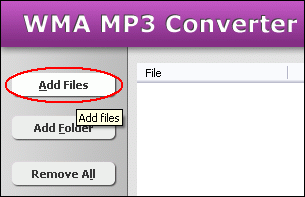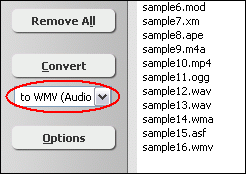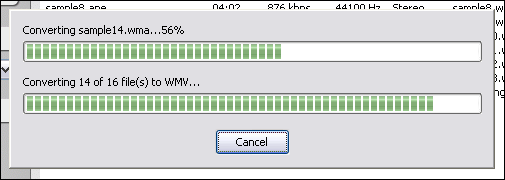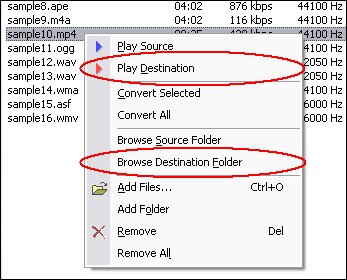ADTS to WMVConvert ADTS to WMV, ADTS to WMV Converter |
 |
| Home | Getting Started | Download | Buy Now! | Screen Shots | FAQ | Support | Contact |
ADTS to WMV Converter converts ADTS to WMV. The software is an ALL-IN-ONE audio converter that supports more than 100 audio and video files. ADTS to WMV Converter supports batch conversion and, is full compatible with Vista and Windows 7.
What is ADTS? AAC compressed audio data may be stored in either an MPEG-4 container file format (.mp4, .m4a) or more basic MPEG-2 based file formats such as a ADTS (.aac, .adts) Audio Data Transport Stream file. An MPEG-4 file contains a header that includes meta-data followed by "tracks" which can include video as well as audio data, for example, H.264 encoded Video and AAC encoded Audio. ADTS in contrast is a streaming format consisting of a series of frames, each frame having a header followed by the AAC data. Therefore, a decoder can start playing a ADTS stream at any point within that stream making it ideal for "radio" like applications. To decode an MPEG-4 file however, the file header must first be read in order to properly playback the file. What is WMV? A WMV file is in most circumstances encapsulated in the Advanced Systems Format (ASF) container format. The file extension .WMV typically describes ASF files that use Windows Media Video codecs. The audio codec used in conjunction with Windows Media Video is typically some version of Windows Media Audio, or in rarer cases, the deprecated Sipro ACELP.net audio codec. Microsoft recommends that ASF files containing non-Windows Media codecs use the generic .ASF file extension. The ASF container can optionally support digital rights management using a combination of elliptic curve cryptography key exchange, DES block cipher, a custom block cipher, RC4 stream cipher and the SHA-1 hashing function. Although WMV is generally packed into the ASF container format, it can also be put into the AVI or Matroska container format. The resulting files have the .AVI and .MKV file extensions, respectively. WMV can be stored in an AVI file when using the WMV 9 Video Compression Manager (VCM) codec implementation. Another common way to store WMV in an AVI file is to use the VirtualDub encoder. Windows Media Video (WMV) is the most recognized video format within the WMV family. Usage of the term WMV often refers to the Microsoft Windows Media Video codec only. Its main competitors are MPEG-4 AVC, AVS, RealVideo, DivX, and Xvid. The first version of the codec, WMV 7, was introduced in 1999, and was built upon Microsoft's implementation of MPEG-4 Part 2. Continued proprietary development led to newer versions of the codec, but the bit stream syntax was not frozen until WMV 9. While all versions of WMV support variable bit rate, average bit rate, and constant bit rate, WMV 9 introduced several important features including native support for interlaced video, non-square pixels, and frame interpolation. WMV 9 also introduced a new profile titled Windows Media Video 9 Professional, which is activated automatically whenever the video resolution exceeds 300,000 pixels (e.g., 528x576, 640x480 or 768x432 and beyond) and the bitrate 1000 kbit/s. It is targeted towards high-definition video content, at resolutions such as 720p and 1080p. Convert ADTS to WMV Related Topics: EAC3 to WMV, MP3 to WMV, RMI to WMV, RA to WMV, S3M to WMV, ULAW to WMV, M2A to WMV, MO3 to WMV, MPC to WMV, OMA to WMV, FLAC to WMV, GSM to WMV, ADX to WMV, RMJ to WMV, IT to WMV, CAF to WMV, MXF to WMV, F4B to WMV, MPGA to WMV, MPA to WMV, M4R to WMV, XM to WMV, QCP to WMV, M4A to WMV, MTM to WMV, OGG to WMV, AU to WMV, ALAW to WMV, TTA to WMV, CDA to WMV
|
| Home | Getting Started | Download | Buy Now! | Screen Shots | FAQ | Support | Contact | Links |
| Copyright © 2007-2014 Hoo Technologies All rights reserved. Privacy Policy |





